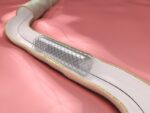Original title: Randomized Trial of Complete Versus Lesion-Only Revascularization in Patients Undergoing Primary Percutaneous Coronary Intervention for STEMI and Multivessel Disease: The CvLPRIT Trial. Reference: Gershlick AH et al. J Am Coll Cardiol. 2015 Mar 17;65(10):963-72. Recent studies such as the PRAMI and the one we summarize here show complete revascularization of AMI patients before discharge...
The MGuard stent shows a trend toward reduced mortality in PCI
Original title: Mesh-Covered Embolic Protection Stent Implantation in ST-Segment–Elevation Myocardial Infarction. Final 1-Year Clinical and Angiographic Results From the MGUARD for Acute ST Elevation Reperfusion Trial. Reference: DariuszDudek et al. CircCardiovascInterv. 2015 Feb;8(2). The MGuard is a micronet mesh-covered stent designed to reduce distal embolization in the context of ST elevation myocardial infarction. In the MASTER study...
Safety and efficacy of DES in saphenous vein bypass graft PCI
Original title: Safety and effectiveness of drug-eluting versus bare-metal stents in saphenous vein bypass graft percutaneous coronary interventions: insights from the Veterans Affairs CART program. Reference: Aggarwal V et al. J Am Coll Cardiol. 2014;64:1825-1836. This study retrospectively evaluated 2471 receiving after saphenous vein graft (SVG) PCI between October and September 2011. Outcomes were compared using propensity...
PCI Superior to Optimal Medical Treatment in Patients with Ischemic Cardiomyopathy
Original title: Fractional Flow Reserve–Guided PCI for Stable Coronary Artery Disease. The FAME 2 Trial Investigators. Reference: Bernard De Bruyne et al. N Engl J Med 2014;371:1208-17. The FAME 2 and the COURAGE studies tested similar hypothesis, only in the first study PCI was guided by fractional flow reserve (FFR) in addition to an angiography. The study hypothesis...
More evidence for unprotected left main PCI
Original title: Outcomes After Emergency Percutaneous Coronary Intervention in Patients UIT unprotected Left Main Stem Occlusion. The BCIS National Audit of Percutaneous Coronary Intervention 6-Years Experience. Reference: Niket Patel, et al. J Am Coll Cardiol Interv 2014;7:969-80 AMI involving unprotected left main is not frequent in catheterization labs since most of these cases present in shock. There is...
Most of stable patients have the wrong idea about the purpose of PCI
Original title: Variation in patients’ perceptions of elective percutaneous coronary intervention in stable coronary artery disease: cross sectional study. Referencia: Kureshi F et al. BMJ. 2014;Epub ahead of print. This study included 991 consecutive patients with stable coronary disease undergoing elective PCI in 10 university and community centers between 2009 and 2011. After procedure, patients were asked a...
Contrast-induced nephropathy in the context of PCI, a lot more frequent in women
Original title: Female gender and contrast-induced nephropathy in primary percutaneous intervention for ST-segment elevatio myocardial infarction. Reference: Stefano Lucreziotti, et al. International Journal of Cardiology 2014;174:37-42 Primary PCI has been demonstrated beneficial. However, it is associated to greater contrast-induced nephropathy (CIN) with increased in hospital and long term morbidity and mortality. In addition, several reports have shown...
Dedicated two everolimus eluting stent strategies improve bifurcation PCI outcomes
Original title: Dedicated two-stents technique in complex bifurcation percutaneous coronary intervention with use of everolimus-eluting stents: The EES-bifurction study. Reference: Nisharamed I. Kherada, et al. International Journal of Cardiology 2014;174:13-17 Bifurcation PCI, especially 1.1.1 Medina bifurcation lesions PCI, is particularly challenging and has been associated with increased restenosis. The use of drug eluting stents (DES) associated to...
Post PCI bleeding can cause kidney injury
Original title: Impact of Periprocedural Bleeding on Incidente of Constrast-Induced Acute Kidney Injury in patients treated with Percutaneous Coronary Intervention. Reference: Yohei Ohno, et al. J Am Coll Cardiol 2013;62:1260-6 Contrast induced acute kidney injury (CI-AKI) is a serious complication associated to higher morbimortality rates and higher costs, but its correlation to bleeding remains controversial. This study included...
The radial approach for PCI reduces mortality
Original title: Radial Versus Femoral Access for Primary Percutaneous Interventions in ST-Segment Elevation Myocardial Infarction Patients. A Meta-Analysis of Randomized Controlled Trials. Reference: Wassef Karrowni et al. J Am Coll Cardiol Intv 2013;6:814–23. Bleeding is the most frequent in-hospital complication of PCI, and it is clearly associated with adverse events that include death. STEMI patients require emergency...









